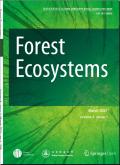Minimal expansion of shrubland on the Tibetan Plateau over the past three decades
IF 4.4
1区 农林科学
Q1 FORESTRY
引用次数: 0
Abstract
Shrubland expansion is a globally occurring phenomenon under global change and has caused a wide range of ecological consequences. However, due to the visual similarity between shrubland and grassland, the accuracy of shrubland interpretation and its spatial distribution varies across different products, making shrub encroachment on the Tibetan Plateau (TP) uncertain. To address these challenges, we developed a phenology-based and pixel-wise method utilizing the Landsat, Sentinel-1, and Sentinel-2 image archives to map shrubland distribution from 1990 to 2022 across the TP. We also investigated the factors affecting shrubland distribution. Using the Random Forest (RF) model, we achieved moderate to high accuracies (Kappa = 0.70–0.81) in predicting shrubland distributions, and we found that shrubland primarily occupies transitional zones between forest and grassland. In the southeast TP, solar radiation intensity is the dominant factor explaining the spatial distribution of shrubland, whereas in arid regions, water availability is the most important. From 1990 to 2022, the shrubland area slightly increased from 3.40% to 4.71%, with expansion showing a clustered pattern, mainly in the shaded aspects of arid regions. The shrubland identification method proposed here shows potential applicability in other areas with similar environmental conditions, such as arid landscapes or high-altitude ecosystems with pronounced seasonal vegetation dynamics. It also plays a crucial role in evaluating vegetation responses to climatic changes.
在过去的三十年里,青藏高原上的灌木丛扩张很小
灌丛扩张是全球变化背景下的全球性现象,造成了广泛的生态后果。然而,由于灌丛与草地在视觉上的相似性,灌丛解译的精度及其空间分布在不同的产品上存在差异,使得青藏高原的灌丛入侵具有不确定性。为了应对这些挑战,我们开发了一种基于物候和像素的方法,利用Landsat、Sentinel-1和Sentinel-2图像档案来绘制1990年至2022年整个青藏高原的灌木分布图。研究了影响灌丛分布的因素。随机森林(Random Forest, RF)模型对灌丛地分布的预测精度达到了中高(Kappa = 0.70 ~ 0.81),灌丛地主要位于森林和草地之间的过渡地带。在青藏高原东南部,太阳辐射强度是解释灌木林空间分布的主导因素,而在干旱区,水分有效性是最重要的因素。从1990年到2022年,灌丛面积从3.40%略微增加到4.71%,扩张呈聚集型,主要集中在干旱区的阴影区。本文提出的灌丛识别方法在其他具有类似环境条件的地区具有潜在的适用性,例如干旱景观或具有明显季节性植被动态的高海拔生态系统。它在评估植被对气候变化的响应方面也起着至关重要的作用。
本文章由计算机程序翻译,如有差异,请以英文原文为准。
求助全文
约1分钟内获得全文
求助全文
来源期刊

Forest Ecosystems
Environmental Science-Nature and Landscape Conservation
CiteScore
7.10
自引率
4.90%
发文量
1115
审稿时长
22 days
期刊介绍:
Forest Ecosystems is an open access, peer-reviewed journal publishing scientific communications from any discipline that can provide interesting contributions about the structure and dynamics of "natural" and "domesticated" forest ecosystems, and their services to people. The journal welcomes innovative science as well as application oriented work that will enhance understanding of woody plant communities. Very specific studies are welcome if they are part of a thematic series that provides some holistic perspective that is of general interest.
 求助内容:
求助内容: 应助结果提醒方式:
应助结果提醒方式:


